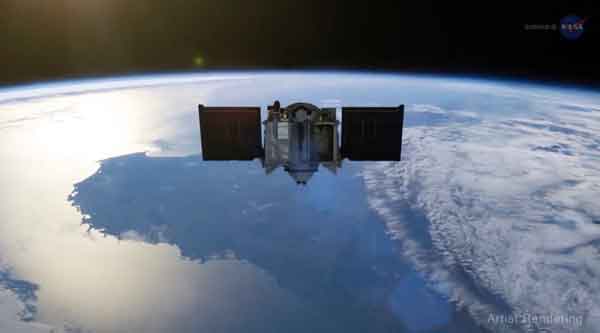

This artist's illustration shows NASA's OSIRIS-REx spacecraft zooming past Earth on September 22 in 2017 — a maneuver designed to boost the probe’s speed and refine its course toward the asteroid Bennu. Photo: NASA
Washington, US (BBN) - A NASA asteroid-sampling probe has just said goodbye to Earth for the second time.
The OSIRIS-REx spacecraft zoomed past our planet this afternoon (Sept. 22), a little over a year after launching on a mission to the big near-Earth asteroid Bennu, reports SPACE.COM.
The probe's closest approach came at 12:52 p.m. EDT (1752 GMT), when OSIRIS-REx passed a mere 10,711 miles (17,237 kilometers) above Antarctica near the southern tip of South America, NASA officials said.
OSIRIS-REx didn't come back because it was homesick. Today's flyby was designed to boost the probe's speed and refine its course toward the 1,640-foot-wide (500 meters) Bennu, whose orbit around the sun is tilted by 6 degrees relative to that of Earth.
"When we do this [flyby], we get close enough to where we start to have that gravitational pull and that momentum change," OSIRIS-REx deputy program scientist Christina Richey, of NASA Headquarters in Washington, D.C., said during a Facebook Live event today, about an hour before closest approach.
"We're going to use that to whiplash around — basically, to change our direction so that we're in the same directional path as Bennu," Richey added.
Such "gravity assists" are common in planetary missions. For example, NASA's Juno Jupiter probe flew by Earth in October 2013 — more than two years after lifting off — and increased its speed by about 8,800 mph (14,200 km/h) in the process. (Juno's flyby was much closer than OSIRIS-REx's; the Jupiter craft came within a mere 347 miles, or 559 km, of our planet.)
Today's flyby increased OSIRIS-REx's speed by 8,451 mph (13,601 km/h), NASA officials said.
Earth rendezvous
The $800 million OSIRIS-REx mission launched on September 8 in 2016. The probe, which has put about 600 million miles (960 million km) on its odometer during its 54 weeks in space, came barreling toward Earth today at about 19,000 mph (30,000 km/h), NASA officials said.
The close approach over Antarctica was expected to take OSIRIS-REx out of contact with its handlers for about 50 minutes.
"OSIRIS-REx uses the Deep Space Network to communicate with Earth, and the spacecraft will be too low relative to the southern horizon to be in view with either the Deep Space tracking station at Canberra, Australia, or Goldstone, California," Mike Moreau, the flight dynamics system lead at NASA's Goddard Space Flight System in Greenbelt, Maryland, said in a statement late last month.
Four hours after its closest approach, the spacecraft will begin studying Earth and the moon to calibrate its science instruments, mission team members said. In a few weeks, they added, OSIRIS-REx's trajectory toward Bennu will be assessed.
NASA and the OSIRIS-REx team have been encouraging the public to observe OSIRIS-REx as it approached Earth (though doing so probably required a telescope with an aperture of at least 8 inches, or 20 centimeters). If you took a photo of OSIRIS-REx in the sky, you can upload it to the mission's "Spot the Spacecraft".
On to Bennu
If everything goes according to plan, OSIRIS-REx will arrive in orbit around Bennu in late 2018. This is no mean feat, mission team members stressed.
"The asteroid’s small size and low gravity makes OSIRIS-REx the most challenging mission that I have worked on," navigation team leader Peter Antreasian, of the Arizona-based company KinetX Aerospace, said in the same statement. "At roughly 500 meters in diameter, Bennu will be the smallest object that NASA has orbited."
OSIRIS-REx will study Bennu from orbit for more than a year. Then, in July 2020, it will make its way to the space rock's surface and snag at least 2.1 ounces (60 grams) of dirt and rock.
In March 2021, the spacecraft will begin the cruise back to Earth with this precious cargo stowed in a return capsule. After reaching the vicinity of our planet in September 2023, OSIRIS-REx will jettison the return capsule, which will make a parachute-assisted landing in the Utah desert. The probe, meanwhile, will put itself into a stable orbit around the sun.
The Bennu sample — the largest collection of cosmic material brought to Earth since the Apollo era — will be studied by scientists around the world. Such analyses should shed light on the solar system's early days, especially the role that primitive, carbon-rich asteroids such as Bennu may have played in delivering amino acids and other building blocks of life to Earth, NASA officials have said.
And there's no telling what else scientists may learn from the Bennu material, which will be studied for years to come, mission team members have said.
Returned samples "are the gift that keeps giving," Jim Garvin, chief scientist at NASA's Goddard Space Flight Center in Greenbelt, Maryland, said during today's Facebook Live event.
The mission may also help researchers better understand the resource potential of asteroids and how to deflect potentially hazardous space rocks away from Earth, according to team members. Indeed, these envisioned contributions are identified in OSIRIS-REx's full name: Origins, Spectral Interpretation, Resource Identification, Security, Regolith Explorer.
BBN/MMI/ANS